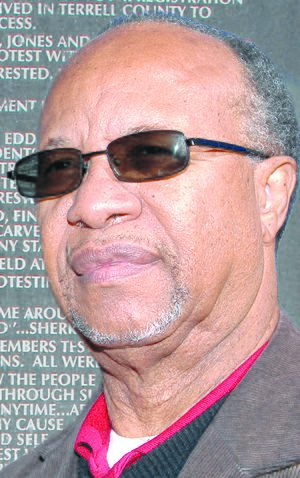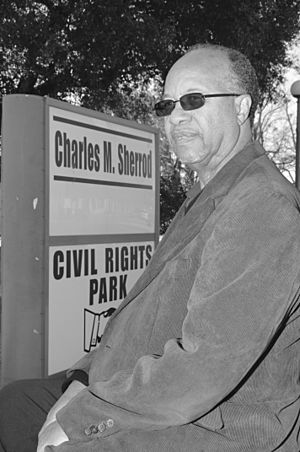Charles Sherrod facts for kids
Quick facts for kids
Charles Sherrod
|
|
|---|---|

Sherrod in 2012
|
|
| Born |
Charles Melvin Sherrod
January 2, 1937 Surry, Virginia, U.S.
|
| Died | October 11, 2022 (aged 85) Albany, Georgia, U.S.
|
| Alma mater | Union Theological Seminary |
| Occupation | Preacher, activist |
| Spouse(s) | Shirley Miller |
Charles Melvin Sherrod (born January 2, 1937 – died October 11, 2022) was an American minister and civil rights activist. He played a big part in the Civil Rights Movement. This movement worked to gain equal rights for African Americans.
Sherrod helped start the Albany Movement in Georgia. He was a field secretary for the Student Nonviolent Coordinating Committee (SNCC). He also joined the Selma Voting Rights Movement. He took part in many other important campaigns of that time.
His work for change continued throughout his life. He worked with the Southwest Georgia Project for Community Education (SWGAP). He also helped create New Communities. Later, he served as a member of the Albany City Council. He was married to Shirley Sherrod, who worked for the U.S. Department of Agriculture.
Contents
Early Life
Charles Sherrod was born in Surry, Virginia. His Baptist grandmother raised him. As a young boy, he sang in the church choir. He also went to Sunday school. When he grew up, he became a preacher. He often preached to children at Mount Olivet Baptist Church.
Civil Rights Movement
Sherrod first joined the Civil Rights Movement after a big court case. The Supreme Court of the United States ruled that public schools must be open to everyone. This happened in the Brown v. Board of Education case in 1954. Sherrod then took part in sit-ins at white churches. These protests aimed to make churches open to all races.
He became a very important member of the Student Nonviolent Coordinating Committee (SNCC). He was the first SNCC field secretary. He also directed SNCC's work in southwest Georgia.
Student Nonviolent Coordinating Committee
Sherrod joined SNCC in 1961. SNCC was looking for new students to join in Rock Hill, South Carolina. At that time, Sherrod was studying at Virginia Union University. He was offered a teaching job. But he chose to join SNCC instead.
In 1961, he and three other students left college. They became full-time civil rights activists for SNCC. The others were Diane Nash, J. Charles Jones, and Ruby Doris Smith. When they arrived in Rock Hill, they quickly joined sit-ins. They were fighting against unfair segregation rules.
After just one day, all four were arrested. They had protested at a local diner. They were sentenced to 30 days of difficult work. They chose to stay in jail instead of paying bail. This was part of a plan called "jail-no bail." The idea was to fill up the jails. This would draw attention to the unfairness of segregation.
After his release, Sherrod became a key SNCC member. Many called him one of its founding fathers. He rose in the SNCC organization. He became the director and field secretary for Southwest Georgia. Sherrod decided to focus on Albany, Georgia. He wanted it to be a center for voter registration in the nearby farming areas.
The Albany Movement
Instead of going back to school, Sherrod moved to Albany, Georgia. He became a full-time organizer there. He wanted to start new efforts for Black people. Albany was a very segregated community. Another SNCC worker, Cordell Reagon, joined him in October 1961. Sherrod was 22, and Reagon was 18.
The main goal of the Albany Movement was to win the right to vote for Black people. They also wanted to end segregation everywhere. This included bus stations and travel between states. They also wanted to get rid of the city's segregation laws.
The movement faced some disagreements among its leaders. Sherrod and Reagon believed in direct action. This meant sit-ins and going to jail. They taught Albany students about nonviolent strategies. Local leaders, however, preferred to talk with city officials.
Sherrod and SNCC also had different ideas from Dr. Martin Luther King Jr. and the Southern Christian Leadership Conference. Sherrod believed in a more democratic approach. He wanted change to start from the local community. He aimed for long-term solutions. Dr. King often used short-term campaigns. These relied on his personal appeal.
Students from Albany colleges and high schools supported the movement. Thirty-two students were later expelled from Albany State University. This was because of their protest activities. Fifty years later, in 2011, these students received honorary degrees. SNCC also used white volunteers. This showed that all races were equal.
Sherrod's direct actions met strong resistance. The Albany police chief, Laurie Pritchett, arrested many protesters. But he avoided obvious violence. This kept the movement from getting national attention. Pritchett also made the "jail-no bail" plan harder. He sent arrested people to jails in other towns. Sherrod remembered that "More than 500 students staged sit-ins and were arrested, jailed and beaten."
Sherrod also faced the constant threat of violence from white people. He said that they had to deal with fear every day.
The Albany Movement did achieve some success. The City of Albany removed all segregation laws in 1963. At the time, some thought the movement had failed. But later, people realized how important it was. It taught valuable lessons for future civil rights campaigns.
Selma Voting Rights Movement
The Selma Voting Rights Movement aimed to get voting rights for African Americans. This happened in Selma, Alabama in March 1965. Sherrod took part in this movement. Other activists like Dr. King and John Lewis were also there.
Very few African Americans in Selma could vote, about 2%. Sheriff Jim Clark stopped Black people from registering to vote. So, the movement decided to march from Selma to Montgomery, Alabama. Montgomery was the state capital. They wanted to show their cause to the nation.
The first march was on March 7, 1965. Police violently attacked the marchers on the Edmund Pettus Bridge. This day became known as Bloody Sunday. A second march started two days later. But it also ended at the bridge.
A third march began on March 21. This time, a federal court order protected them. The Alabama National Guard and federal agents were also there. This march reached Montgomery on March 24. Members of SCLC, SNCC, and community members joined. The march brought national attention to voting rights.
Departure from SNCC
Sherrod believed in racial integration. He recruited both white and Black members for voter registration. Sherrod left SNCC at the end of 1966. The head of SNCC, Stokely Carmichael, wanted to exclude white people from the group. Sherrod disagreed with this idea. He decided to focus his efforts on the Southwest Georgia Project (SWGAP) instead.
Southwest Georgia Project for Community Education
After leaving SNCC, Sherrod and his wife Shirley Sherrod started working with the Southwest Georgia Project for Community Education (SWGAP). Their work in Albany helped spread the movement to 15 counties in southwest Georgia. He then recruited students from the Union Theological Seminary. He had earned his master's degree there.
Sherrod wanted to continue his work for nonviolence and equal rights. The main goal of SWGAP is to teach, involve, and empower communities. This project focuses on three main areas: food, farms, and human rights. They work with New Communities and land trusts. The food program aims to make food more available. It also helps communities with food access. The farming program helps family farms and farms that need support. Since Sherrod was an activist, human rights for all was also a key focus. Sherrod hoped this work would lead to better food security. He also wanted to strengthen the economy and pass farmland to new generations. Shirley Sherrod continues to lead SWGAP today.
Later Life
Sherrod earned his master's degree in sacred theology. This was from the Union Theological Seminary. He then returned home to direct the Southwest Georgia Project. His wife Shirley Sherrod worked with him. In 1969, Sherrod, Shirley, and others from the Albany Movement helped start the land trust movement in the U.S. They co-founded New Communities. This was a collective farm in Southwest Georgia. It was based on the idea of kibbutzim in Israel.
He later served on the Albany City Council. He was an elected member from 1976 to 1990. In his later years, Charles Sherrod worked as a chaplain at the Georgia State Prison. He also taught at Albany State University.
Sherrod and his wife had two children. Charles Sherrod passed away on October 11, 2022.
See also


